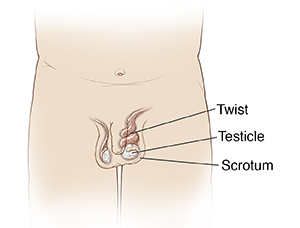What is testicular torsion in children?
Testicular torsion is a painful twisting of the testicles and spermatic cord. The spermatic cord is a set of nerves, ducts, and blood vessels that leads from the groin to the testicles. Torsion can happen to 1 or both testicles. Torsion causes blood to not flow to the testicles. This can damage them. Treatment needs to be done right away to prevent long-lasting (permanent) injury to the testicles.
What causes testicular torsion in a child?
Testicular torsion in young children and teens occurs when the testicles are not completely attached in the scrotum. This lets the testicles move more freely and twist. Torsion may happen during physical activity.
Testicular torsion in a baby happens when the sac around the testicles doesn’t attach to the scrotum.
Which children are at risk for testicular torsion?
Testicular torsion often occurs in children ages 10 and older. It can also happen when a baby is growing in the birth parent's uterus, or shortly after a baby is born. The condition is sometimes seen in fathers, sons, and brothers. This means it may be linked to a gene.
What are the symptoms of testicular torsion in a child?
The severity of the symptoms depends on if the testicle is partly or fully twisted. Symptoms can occur a bit differently in each child. The scrotum may be:
-
Painful (the pain is often very severe)
-
Red
-
Swollen
-
Firm (in a baby)
-
Bruised (in a baby)
-
Closer to the groin
Your child may also have nausea and vomiting.
Testicular torsion is a surgical emergency. If you think that your child has testicular torsion, take them to an emergency room (ER) right away for evaluation.
The symptoms of testicular torsion can seem like other health conditions. Make sure your child sees their healthcare provider, or is seen in the ER, for a diagnosis.
How is testicular torsion diagnosed in a child?
The healthcare provider will ask about your child’s symptoms and health history. They may also ask about your family’s health history. The provider will give your child a physical exam. They will also have tests, such as an ultrasound. This is a painless imaging test. It uses sound waves to see the scrotum and testicles and check blood flow.
How is testicular torsion treated in a child?
Testicular torsion often needs to be treated right away. The more severe the torsion, the more quickly treatment is needed. In some cases, the torsion may be untwisted by hand. But surgery is still needed to keep the testicle in place so torsion can’t occur again. To reduce the risk of long-term problems, surgery should be done within 6 hours of symptoms. Surgery can also help stop torsion from happening again.
Talk with your child’s healthcare providers about the risks, benefits, and possible side effects of all treatments.
What are possible complications of testicular torsion in a child?
If the condition is not treated quickly, it can lead to loss of the testicle.
When should I call my child’s healthcare provider?
Testicular torsion is a medical emergency. If you think that your child has testicular torsion, they should be taken to an emergency room right away for evaluation.
After surgery, call the healthcare provider if your child has:
-
Symptoms that don’t get better, or get worse
-
New symptoms
Key points about testicular torsion in children
-
Testicular torsion is a painful twisting of the testicles and spermatic cord. It can happen to 1 or both testicles.
-
Torsion causes blood to not flow to the testicles. This can damage them. To reduce the risk of long-term problems, surgery is often done within 6 hours of symptoms.
-
It often occurs in children ages 10 and older. It can also happen when a baby is growing in the uterus, or shortly after a baby is born. The condition may be linked to a gene.
-
Symptoms can include a painful, red, and swollen scrotum, and nausea and vomiting.
-
If the condition is not treated quickly, it can lead to loss of the testicle.
Next steps
Tips to help you get the most from a visit to your child’s healthcare provider:
-
Know the reason for the visit and what you want to happen.
-
Before your visit, write down questions you want answered.
-
At the visit, write down the name of a new diagnosis and any new medicines, treatments, or tests. Also write down any new instructions your provider gives you for your child.
-
Know why a new medicine or treatment is prescribed and how it will help your child. Also know what the side effects are.
-
Ask if your child’s condition can be treated in other ways.
-
Know why a test or procedure is recommended and what the results could mean.
-
Know what to expect if your child does not take the medicine or have the test or procedure.
-
If your child has a follow-up appointment, write down the date, time, and purpose for that visit.
-
Know how you can contact your child’s provider after office hours. This is important if your child becomes ill and you have questions or need advice.
Featured in


